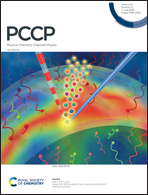Propene oxidation catalysis and electronic structure of M55 particles (M = Pd or Rh): differences and similarities between Pd55 and Rh55†
Abstract
Propene oxidation is one of the important reactions that occurs in the presence of a three-way catalyst but its reaction mechanism is unclear. The reaction mechanisms and differences in catalysis between Pd and Rh particles were investigated by DFT calculations employing Pd55 and Rh55 as the model catalysts. The O-attack mechanism, in which the O atom adsorbed on the Pd55 and Rh55 surfaces attacks the C![[double bond, length as m-dash]](https://www.rsc.org/images/entities/char_e001.gif) C double bond of propene, needs to overcome a large activation barrier (Ea). On the other hand, C–H bond cleavage of the methyl group of propene easily occurs with moderate Ea; the mechanism initiated by this C–H activation is named H-transfer mechanism. In this mechanism, the next step is allyl alcohol formation, followed by the second C–H bond activation of the CH2OH species of allyl alcohol, and the final step is proton transfer from OH-substituted π-allyl species to the OH group on the metal surface to yield acrolein and water molecules with the regeneration of M55. The rate-determining step is the second C–H bond activation. Its Ea is 17.4 kcal mol−1 for the reaction on Pd55 and 34.4 kcal mol−1 for the reaction on Rh55. These results indicate that Pd particles are more active than Rh particles in propene oxidation, which agrees with the experimental findings. The larger Ea for Rh55 than that for Pd55 arises from the stronger Rh–OH bond than the Pd–OH bond. The higher energy d-valence band-top of Rh55 than that of Pd55 is the origin of the stronger Rh–OH bond than the Pd–OH bond. Thus, the d-valence band-top energy is an important property for understanding and designing catalysts for alkene oxidation.
C double bond of propene, needs to overcome a large activation barrier (Ea). On the other hand, C–H bond cleavage of the methyl group of propene easily occurs with moderate Ea; the mechanism initiated by this C–H activation is named H-transfer mechanism. In this mechanism, the next step is allyl alcohol formation, followed by the second C–H bond activation of the CH2OH species of allyl alcohol, and the final step is proton transfer from OH-substituted π-allyl species to the OH group on the metal surface to yield acrolein and water molecules with the regeneration of M55. The rate-determining step is the second C–H bond activation. Its Ea is 17.4 kcal mol−1 for the reaction on Pd55 and 34.4 kcal mol−1 for the reaction on Rh55. These results indicate that Pd particles are more active than Rh particles in propene oxidation, which agrees with the experimental findings. The larger Ea for Rh55 than that for Pd55 arises from the stronger Rh–OH bond than the Pd–OH bond. The higher energy d-valence band-top of Rh55 than that of Pd55 is the origin of the stronger Rh–OH bond than the Pd–OH bond. Thus, the d-valence band-top energy is an important property for understanding and designing catalysts for alkene oxidation.

- This article is part of the themed collection: 2020 PCCP HOT Articles


 Please wait while we load your content...
Please wait while we load your content...